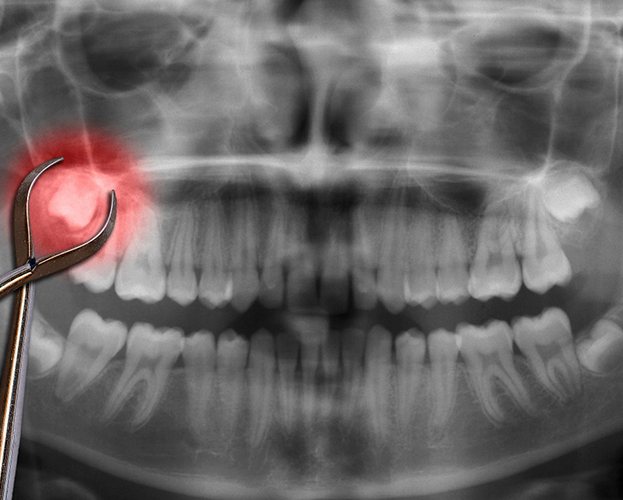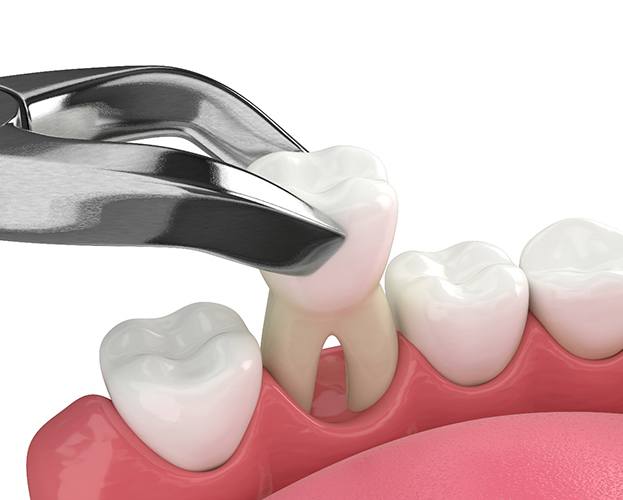Tooth Extractions – Williamsville, NY
Removing a Tooth Can Save the Rest
Obviously, keeping all of your natural teeth intact will be our top goal whenever we consider options for treating tooth decay, fractured structure, and other oral health issues. But if the damage that has already occurred is too great, or if there’s a particularly advanced infection that threatens to spread throughout the mouth, we may need to go ahead and plan a tooth extraction, which we will make sure is performed as efficiently and comfortably as possible. Call Amherst Dental Group today to schedule an appointment if you think you need tooth extractions in Williamsville, NY.
Why Choose Amherst Dental Group for Tooth Extractions?
- Dental Implants Placed In-House
- Relaxing, Gentle Sedation Offered
- Beautiful, Realistic Restorations
Reasons Why Tooth Extractions Are Necessary

There are many justifications for removing a tooth, including:
- Tooth Decay: If tooth decay was not treated in time, it can consume the majority of the tooth or spread to other teeth or the jawbone. At some point, root canal therapy might not be sufficient to salvage the tooth, at which point removal is the only option.
- Tooth Cracks: When a crack extends below the gumline, the tooth cannot be salvaged and needs to be removed and replaced.
- Gum Disease: Over time, gum disease destroys the tissues anchoring the teeth to the gums and jaw. Loose teeth may need to be extracted. In fact, gum disease is the leading cause of tooth loss in adults worldwide.
- Overcrowding: Sometimes teeth are too crowded together to be corrected with orthodontic treatment, making extraction necessary.
- Impaction: Some people develop a third set of molars in their late teenage or early adult years. If these are oriented at an angle or the mouth doesn’t have sufficient room, these teeth may need to be extracted to preserve the rest of the patient’s smile.
The Process of Removing a Tooth

The area around the tooth will be numbed so that you don’t experience any pain. The next step depends on whether a simple or surgical extraction is being performed. For a simple extraction, we use a special instrument called an elevator to rock the tooth back and forth, which loosens the tooth before we take it out with forceps. A surgical extraction, on the other hand, requires us to remove a small amount of gum tissue and bone to access the tooth in question. We may also have to divide the tooth into sections in order to remove it more efficiently.
Tooth Extraction Aftercare

Regardless of the type of extraction you have, recovery usually looks similar. It is imperative that a blood clot form over the site to protect the vulnerable healing tissues underneath. Without it, you could develop an infection called dry socket. As a result, you need to follow the instructions we give you before you go home to rest.
For several days, you should not be extremely active, and you need to have clean gauze on the site for a few hours following the procedure. You may take over-the-counter pain medication and hold a cold compress over your face to manage any discomfort. Eat softer foods, but do not use a straw because the force of the sucking motion can dislodge the clot. After a few days, you may try to resume a more normal diet as tolerated. Be very careful around the site when you brush and floss your teeth.
If you experience a fever or increasing pain, give our office a call immediately.
I Need a Checkup & Cleaning I Need a Dentist for My Child I am Concerned about Bleeding Gums I Have a Cavity or Broken Tooth I am Missing One or More Teeth I am Unhappy with My Smile I Want a Straighter Smile I am Scared of the Dentist I am in Pain & Need Help I Need My Wisdom Teeth Removed View Our Services

